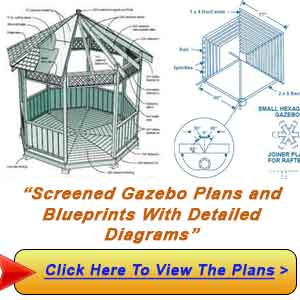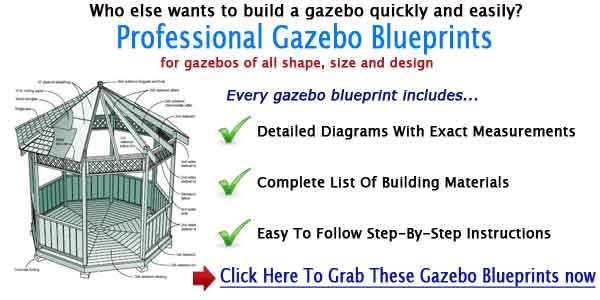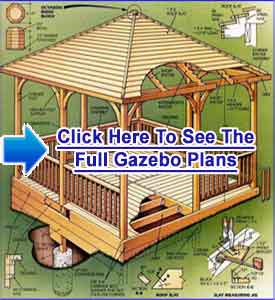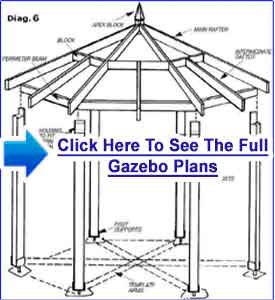 Screened gazebo plans are well preferred construction plans across the country, whatever the prevailing season in that area is. Not only screens are more convenient and affordable, they can also serve multiple purposes that will suit almost all kinds of locations and backyard landscape.
Screened gazebo plans are well preferred construction plans across the country, whatever the prevailing season in that area is. Not only screens are more convenient and affordable, they can also serve multiple purposes that will suit almost all kinds of locations and backyard landscape.
Whether it is to complement your garden landscape, accent a backyard pond, offer a viewing spot to take advantage of the breathtaking environment or just serve as a relaxing haven as an extension of your home, gazebo construction plans of this type will always be a most favored construction design.
Fortunately, there is no need for you to hire a professional architect just to have the wonders of enclosed gazebo plans in your own backyard. Here are some tips in constructing the perfect gazebo for your family.
Permanent vs. Portable screened gazebo plans
Decide whether your screened gazebo plans will be permanent or portable structure. The two aforementioned options will make big differences in the convenience of work, price of materials to be used and the entire construction process. Both gazebo blueprints for permanent structure and commercially available portable gazebos feature screens that ensure safety of the family from insects and lingering animals but do not limit the natural ventilation in any way.
Making your own gazebo blueprints has so many advantages, from creative freedom to saving hundreds of dollars on professional fees. Nevertheless, this is more recommended for those planning to have a permanent structure since gazebo plans for sale for portable ones are being sold in the market and online.
Metal vs. Fabric screens in gazebo construction plans
The two most common types of screens used in gazebos are the standard and traditional screens made of metal wires and those made of fabrics. Both of them are convenient and portable but they differ in use, features and durability. Nonetheless, they serve the same purpose of protection although they vary in degree of effectiveness.
Having the walls screened in gazebo plans using metal wires lasts longer compared to its fabric counterpart and will stand tougher against extreme weathers like rain, wind and long exposure to sunlight. Metal screens are easier to clean and attach to the whole structure. However, they also come in higher prices.
Fabric screens on the other hand act as screen and curtain at the same time due to their flexible nature. You can buy them in ready-made curtain screens or have them arranged by yourself to fit your creative preference. Fabrics are recyclable but are also harder to clean and after long exposure to weather changes, they may change in appearance and quality which may shout “replacement.”
Motorized vs. permanently attached screens in enclosed gazebo plans.
Even gazebo screens got into a modern era and that means less human work for you. Motorized screens for enclosed gazebo plans have panels that retract vertically or horizontally in just one push of a button, and they may also be used even with wooden gazebo plans. Often used with outdoor hot tubs, these high-tech contraptions are now made available so you can easily convert your enclosed gazebo into a fully open-sided one.
Permanent screens may seem too boring for some, but homes with older family members prefer the simplest of amenities, not to mention the savings in electricity that you will have by sticking with the traditional ones.
Enclosed gazebo plans vs. wooden canopy plans
In essence, plans of wooden canopies are types of open wooden gazebo plans—both of them function the same. An enclosed gazebo can be totally closed on all sides like a regular part of the house while a wooden canopy is often built as a separate section by using just wooden roof accents and posts (making it absolutely penetrable by sunlight and rain) to make a seemingly new “enclosure.” The latter is often used in gardens where there are wide varieties of vines that can cover the wood roof (or beams) to serve as protection against rain and sunlight. Many architects consider wooden canopies as a mere type of mini rotunda or pergola.
However, many gazebo plans for sale that try to offer new concepts combine the two architectural plans by incorporating supposedly open wooden canopies, detachable screens and portable roofs. If you are designing your own gazebo, you can have it however you want for as long as you and your family’s preference will be satisfied.
Gazebo plans for sale vs. conceptualizing your own blueprint
The good thing about ready-made gazebo plans is that they are made by professional architects and interior designers. Some companies that offer this service even entertain collaboration with your own preference—you give your specifications while they do the professional execution.
Nonetheless, it is still highly recommended that you build your own gazebo using your own plan and readily-available materials so you can pinpoint what result you exactly have in mind. Fortunately, there are lots of materials being sold that are meant to make gazebo construction as portable and convenient as much as possible.
Total gazebo foundation vs. freestanding poster gazebo as used in gazebo blueprints
For wooden gazebo plans and open-sided gazebo plans, poster foundations are often being used for as long as the structure is small. For permanent structures through, full foundation is what building authorities and architects recommend. This means the foundation beams, floor and walls will be constructed same as how a house is built.
Concrete is the material of choice and the rule is that you should have at least 18 inches of footing depth and deeper for areas with frost problems. Every corner should have one footing. By bolting gusset plates onto the concrete foundation, the whole structure should be highly stable even under extreme weather conditions.
For the foundations, at least four inches of thickness should be used to keep it sturdy. This is also applicable for wood slabs.
Practicability vs. design in making enclosed gazebo plans
If it comes to dead-end, do not sacrifice the practicability over design because it will always be the performance and not the aesthetic properties that will be the deciding factor of the structure’s effectiveness in serving its purpose. If a specific material is solely recommended for your area, just stick with it instead of using something that fits your visual preference but cannot deliver expectations.
If you like an Asian-inspired gazebo but having the walls screened in gazebo plans will distort the whole theme, better leave the design off than risk having insect bites. Incongruence in practical use and aesthetics will not happen if you will carefully plan the whole construction from the beginning.







